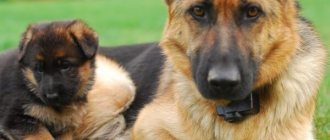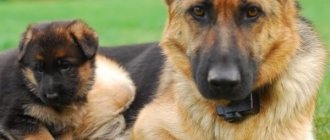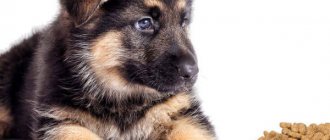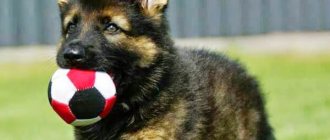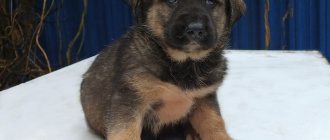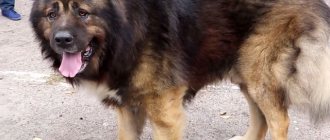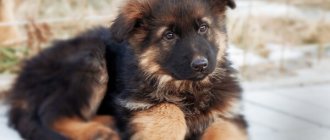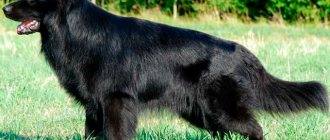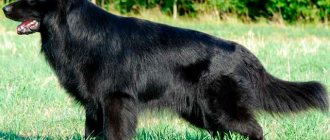The German Shepherd has been and remains the most popular and sought after breed. The reason for this is a magnificent exterior, a powerful, harmonious physique, high intelligence and excellent service qualities. The demand for German puppies is huge, so unscrupulous breeders, in pursuit of quantity and profit, allow matings with individuals classified as mestizos. In such a situation, it is important to be able to accurately identify a purebred German Shepherd puppy and know how to distinguish it from a cross with a mongrel.
Origin story
The ancestors of the species were the Indian wolf and the wild dog. Their remains were discovered in Central European territories. The breed received the name German Shepherd because of its main working function (herding sheep).
This is interesting: What is the name of the mestizo from crossing a husky with a shepherd
These representatives were first mentioned in the 16th century. They were portrayed as powerful and brave animals that could protect their owner and his home.
Breeding was carried out in the German cities of Württemberg and Thuringia. Dog breeders selected individuals based on their protective qualities and appearance. At first, the German Shepherd puppies did not meet the stated requirements.
In Europe by the end of the 19th century. The number of four-legged animals began to increase along with the growing popularity of herding dogs. Many varieties of the breed have appeared.
In 1890, the first clubs for lovers of these dogs began to be organized. The basic standards and requirements for the variety were also prescribed. Soon, the purebred German Shepherd dog became famous in many countries.
For the first time, the German Shepherd was presented at an international exhibition in Hanover in 1882. Then the FCI published standards in the description of the breed and its character.
In the 20s, breeders, wanting to make money, began crossing shepherd dogs with other German individuals, which led to changes in their appearance and character. Purebred German Shepherds have become increasingly rare. This continued until the 1925 Conference. Then it was decided to return the breed to its original characteristics.
German shepherds appeared in Russia in 1904 and immediately served in the police. As a result of breeding work, domestic individuals began to differ from their counterparts from Germany.
During times of war, animals acted as orderlies, sappers and guides.
From Greif to Horand: the formation of the German breed
The first written mention of the ancestors of German Shepherds dates back to the 7th century. During excavations in Swabia (southwestern region of Germany), a document was discovered describing large wolf-like dogs that lived in human settlements. The manuscript does not contain information about the then name of the dogs or their purpose, but it contains the most curious fact: killing a dog was considered a serious crime for which the killer was sentenced to death.
Despite its centuries-old history, the formation of the German Shepherd breed began only in the 19th century. Many people, both professional breeders and businessmen pursuing selfish goals, tried to create a new breed of dogs with ideal external data and a set of qualities such as intelligence, devotion and unquestioning obedience to the owner. But only one person was able to achieve success in this field and his name was Max Emil von Stefanitz.
Mr. Stefanitz was not a dog trainer or an experienced breeder. He held the position of captain in the cavalry forces, where his duties included the purchase and drill training of war horses. On duty, von Stephanitz traveled all over Germany, often visiting rural areas and farms, where he noticed shepherd dogs deftly managing livestock grazing. Max liked the animals so much that after retiring, he decided to devote his life to a noble goal - creating a breed of dogs that would become a national treasure of the country.
A long search for shepherd dogs that meet the given parameters, several years of painstaking selection work, and now the first name of a representative of the new breed - Greif - was entered into the stud book. The dog had a powerful physique, endurance and unconditionally obeyed any order. Only one thing upset von Stefanitz: the appearance of the pet, or rather its dull, dirty-gray color, was not quite suitable for the future symbol of Germany.
And the retired captain again began searching for the ideal dog, until at one of the exhibitions he saw a dog entertaining the audience with funny tricks. Von Stefanitz looked at the male dog named Hector with admiration and could not believe his luck. The dog had strength, agility and an ideal physique, but most importantly, Hector had an impeccable yellow-gray coat color. Max immediately offered the owner of the shepherd a decent amount for the dog, but he became stubborn and flatly refused to sell the pet. Mr. Stefanitz pursued the intractable owner for several months, and his persistence was crowned with success. Hector was bought out, renamed Horanda von Grafrath and transported to Max's kennel.
And the breeder's Horand did not disappoint! Max's favorite pet has repeatedly become a champion and prize-winner of various exhibitions. But the main thing is that Horand turned out to be an excellent sire, his offspring were distinguished by good health and inherited only the best qualities from their father. So the dog with an aristocratic name, beautiful exterior and positive character became the official ancestor of the new breed.
Inspired by this success, in 1889 Stefanitz, together with like-minded people, founded the first German Shepherd Club. Through their joint efforts, a description of the breed, exterior standards and the nuances of their breeding were included in the stud book. And it took only 20 years for these amazing animals to be recognized far beyond the borders of Germany.
Important: after World War II, the number of German Shepherds decreased by almost half, and they were on the verge of extinction. And only through the efforts of Max von Stephanitz’s followers was it possible to increase the dog population and revive the breed.
Characteristics and standards
Despite the fact that the International Association of Cynologists has adopted specific parameters for show German Shepherds, they differ in different countries.
- Height – 60-65 cm at the withers.
- Weight – up to 25 kg.
- The head is medium or large in size. The ears are set high and pointed upward. The ratio of muzzle and skull is 1:1.
- The eyes are set symmetrically and deeply. Brown color.
- The nose is smooth and straight. The lobe is black, cold, wet.
- Teeth. Full row. Scissor bite. The jaw is powerful.
- The neck is smooth, straight, with developed muscles.
- The chest is massive, arched.
- The tail is medium in size and lowered when calm.
- The body is strong and toned.
Appearance
What does the animal look like? Breed standard.
The head is wedge-shaped, with a long face. Nose is black. The eyes are medium-sized, almond-shaped, set slightly obliquely, not protruding. The color is dark. The ears are straight, medium-sized, parallel, cone-shaped. Powerful mouth with a scissor bite. The upper incisors closely overlap the lower ones. The teeth are strong, light, there are 42 of them.
— Advertising —
The neck is strong, muscular, neat and relatively long. It is proportional in size to the head, without loose folds of skin. The back is straight and well developed. The chest is moderately wide and deep. Forelegs: shoulder blades long, sloping, placed flat. When viewed from all sides, the legs are straight. The hind legs are parallel, with muscular thighs. The tail should reach at least to the hock joint.
Males are usually larger than females. The normal weight of individuals is 22-40 kg, height is 55-65 cm.
The breed has a thick double coat of coat that protects from the elements. The outer coat is harsh, while the undercoat is fluffy, soft and dense. The head, inner ear and forehead, as well as the legs and paws are covered with short hairs. The neck comes with longer and thicker hairs.
Most common colors:
- Black.
- Black and red.
- Sobolinaya.
- Brown.
- Rare: gray color.
Black and zoned are special names for popular coat colors.
Advantages and disadvantages
Choosing a pet is a responsible undertaking. A small, funny German Shepherd puppy will turn into a large male in 4 months, requiring training, quality nutrition and serious investment.
Before getting such a pet, which will live in the family for more than 10 years, you need to familiarize yourself with information about the breed, study the characteristics of behavior and character. And only then make a decision. The main thing is to consider all the pros and cons.
Shepherd's strengths:
- developed mind;
- unpretentiousness;
- security abilities;
- lack of excessive aggression;
- universal working qualities;
- endurance;
- devotion to the owner and his family.
Flaws:
- cannot be kept in a small apartment;
- high activity;
- some individuals are characterized by aggression;
- daily active walks are required;
- an adult has a specific odor;
- frequent shedding.
There are definitely more pros than cons. German Shepherds are ideal for families with children living in a country house. She will perform her main function of protection and is in the wild. The main disadvantage is that such an individual does not feel well in a small apartment.
Age compared to human years
| Person's age | German Shepherd age | Compliance factor |
| 14 months | 2 months | 7.0 |
| 5 years | 6 months | 10.0 |
| 9 years | 8 months | 12,5 |
| 14 years | 12 months | 14.0 |
| 20 years | 18 months | 13,3 |
| 24 years | 2 years | 12.0 |
| 30 years | 3 years | 10.0 |
| 36 years | 4 years | 9.0 |
| 40 years | 5 years | 8.0 |
| 42 years | 6 years | 7.0 |
| 49 years old | 7 years | 7 |
| 56 years old | 8 years | 7 |
| 63 years old | 9 years | 7 |
| 65 years old | 10 years | 6,5 |
| 71 years old | 11 years | 6,5 |
| 75 years old | 12 years | 6,2 |
| 80 years old | 13 years | 6,3 |
| 84 years old | 14 years | 6,2 |
| 87 years old | 15 years | 5,8 |
| 89 years old | 16 years | 5,6 |
Varieties
German Shepherds are the most sought after dogs in the world. Their unique working qualities are used in many countries. They can be entrusted with any task.
There are dozens of bred lines of the breed. They are divided by color, coat length, and selection characteristics.
Types of colors:
- Black. The rarest variety. Only 5% of individuals in the world have this coat color. German Shepherd lovers are hunting for an elite dog. Such dogs are presented at exhibitions and shows.
- Black with tan markings (triangular or trapezoidal) on the chest, belly and paws.
- Zonal. Separately, each hair is colored with either light or dark rings.
- Black-and-white. The back is completely black. Paws, chest, belly with red, wheat, gray, chocolate tan.
- White. "Blondes" are often found in America and Canada. A special recessive gene is the reason for the rare color.
- Ginger. It is considered a deviation from the norm, according to the International Canine Association (FCI). They do not differ in character and operational functions from their classic counterparts.
- Grey. Still unrecognized color.
German Shepherds are short-haired animals. The hair is hard and fits tightly to the body. There is a thicker “robe” on the neck, hind legs and tail.
Kinds
There are a sufficient number of varieties of shepherd dogs relative to breeding lines:
- German: working lines.
- German: exhibition lines.
- German: East German line.
- Czech/Slovak.
- American.
- Old American.
- Old type.
- English.
- Swiss (mountain).
- Belarusian.
- Caucasian.
- Russian.
- Chinese.
- Central Asian.
And:
- Panda.
- Shepherd dogs without a mask.
- Shiloh Sheepdogs.
- Royal Shepherd.
- Old style German Shepherd.
- Kunming Shepherd.
- Sarlouz Wulfhound.
- Utonogan.
- American tundra.
- Dwarf.
- Gypsy.
- Black German Shepherd.
Photos of different types are presented below.
Longhair
The long-haired type (long-haired) is not considered a separate breed. The recessive gene for long hair is present in all lines and subspecies of individuals. It may appear unexpectedly. Sometimes a slight lengthening of the hairs is possible, and the appearance of very long hair is possible. In such cases, caring for your pet will be more difficult.
The photo is presented below.
Maintenance and care
Before you bring home a new family member, you need to choose a place for him. You cannot arrange a “bed” for a German Shepherd puppy near a window or door. Constant drafts will negatively affect his health.
Expert opinion
Anna Abramenko
An avid dog lover. Experience in veterinary medicine since 2009.
Ask a Question
The pet should not lie on the bare floor. He will be more comfortable and warm on a feather bed or mattress. You need to lay a cloth on top and change it when it gets dirty.
It takes a long time for German Shepherds to become adults, about 3 years. All this time they are considered teenage puppies and require special care. Due to puberty and developmental characteristics, they should be washed more often and seen by the veterinarian regularly.
A one-month-old German Shepherd puppy, finding itself in a new place, may whine and worry about separation from its mother and its kennel brothers. He needs to be calmed down with petting and kind words.
The toilet for your pet can be located in the house for the first time. You need to gradually instill the habit of relieving yourself outside. For example, during the first month the puppy does this after its main meals.
Expert opinion
Anna Abramenko
An avid dog lover. Experience in veterinary medicine since 2009.
Ask a Question
German Shepherds are unpretentious. The main thing is to keep the coat clean and brush it during the shedding period.
If there is a pond near your house, you can let the dog swim in it. But this is only permissible in the warm season.
We must not forget about mandatory vaccination. It will protect the animal from infections and serious diseases. You should also check the dog’s skin for the presence of fleas and ticks, and if necessary, use a special anti-parasite spray or shampoo.
| Dog vaccination | |
| Age (weeks) | Vaccine |
| 6 | Nobivac Puppy DH |
| 8 | Nobivac DHPPI+L |
| Eurikan DHPPI-L | |
| Duramun Max5/4L | |
| 12 | Nobivac DHPPI+L |
| Eurikan DHPPI-L | |
| D. Max5/4L | |
| After changing teeth* | Nobivac DHPPI+L |
| Eurikan DHPPI-L | |
| D. Max5/4L | |
| Per year, then annually | Nobivac DHPPI+L |
| Eurikan DHPPI-L | |
| D. Max5/4L | |
If your shepherd has become lethargic and is not eating well, you should immediately show it to the veterinarian. Only he will make the correct diagnosis and prescribe effective treatment.
Interaction with children
Caring nanny for the baby. A reliable bodyguard and guardian for a schoolchild. A tireless companion and partner for a teenager. This is exactly how German Shepherds can be characterized when it comes to their attitude towards children. These dogs adore the youngest members of the family, so they can be safely kept in a home with children of any age. And watching the cheerful fuss between a German shepherd and a child, one can only be amazed at the neatness and boundless patience of the pet.
No matter what game the child suggests, the four-legged pet will delightfully keep him company. The dog will become a “patient” for the baby and will steadfastly withstand all the injections and hammer taps from the little doctor. With cool dignity, he will allow himself to be put on toy antlers or a crown if the child decides to make his shaggy friend a “princess” or a “Christmas reindeer.” And he will even turn into a horse for the baby, riding him on his strong, wide back.
A striking example of the fact that the German breed is kind and caring towards children, even strangers, is the shepherd Sophie. The dog saw a girl floundering in the river and instantly realized that the child needed help. She rushed into the water and pulled the baby ashore. This incident is surprising not only because Sophie rushed to the aid of a completely unfamiliar child. The most amazing thing about it is that the shepherd did not hear the girl’s screams, since she was deaf, but acted on a purely instinctive level.
Education and training
Accurate execution of any commands, discipline, obedience are qualities inherent in the German Shepherd breed. Due to their mental stability and pliability, they are easy to train. Education is possible even for a teenager or an owner at home.
It is important to establish contact with the animal as soon as it appears in the apartment. Shepherds are very smart animals. For them, the main thing is to clearly understand the owner’s requirements.
The Germans cannot be punished. It is not recommended to get angry and humiliate them. Such actions can provoke distrust of the owner and a psychological block in the dog.
Despite their obedience and apparent calmness, German Shepherd dogs can be aggressive and, if improperly trained, can turn into a real uncontrollable wolfhound.
A German Shepherd pet must trust its owner. To achieve this, rewards are used in the form of petting, praise and dog treats. Thus, the four-legged animal will warm up to the person and make contact. Therefore, in order for a German Shepherd puppy to become a house guard or a bodyguard for children in the future, it is worth using the services of professional dog handlers. It's not free, but the results will not be long in coming.
Nutrition
German Shepherds have food preferences. If the dog is passive or elderly, fatty foods are excluded from the diet. Young workers must consume a lot of protein to replenish expended energy.
Useful article: What to feed a German Shepherd puppy: the best dry food for shepherds
Dog handlers recommend sticking to the following percentages and product use:
- protein – 70%;
- meat without skin, bones;
- cottage cheese, chicken egg, offal;
- carbohydrates – 40%;
- cereals, vegetables, fruits;
- fats – 20-40%.
It is prohibited to overfeed a German with meat. The diet should be balanced.
A shepherd puppy is fed according to the following scheme (type of food: natural or dry, does not affect the ratio):
- 1-2 months – 1 glass of food for 6 meals;
- 2-3 – 1.5 tbsp. 5 times a day;
- 3-6 – 1 liter for 4 times;
- 6-12 – 1.5 l for 3 doses per day.
At the age of 1 year, a German Shepherd pet eats the same as adults - 2 times a day. It is important not to overfeed a growing dog. This can lead to obesity and related diseases.
A properly formulated diet is the key to your pet’s health. If his body receives a sufficient amount of microelements from puppyhood, then in the future he will not only look good, but also feel good.
| Puppy age in months | Number of feedings per day | Meat/g | Cereals/g | Vegetables and herbs/g | Milk/g | Chicken egg/pcs. (in 2-3 days) | Fish oil/h. l. | Salt/g | Bone meal/g | Calcium phosphate/finely crushed eggshell/g |
| 1-2 | 6 | 100-200 | 80-100 | 130-150 | 400-450 | 1 | 0,5 | 5 | 10 | 0,5 |
| 2-3 | 5 | 200-300 | 100-150 | 150-170 | 450-500 | 1 | 1 | 5 | 10 | 0,5 |
| 3-4 | 5 | 300-400 | 150-200 | 170-190 | 500 | 1 | 1,5 | 8 | 13 | 1 |
| 4-5 | 4 | 400-450 | 200-250 | 190-210 | 500 | 1 | 2 | 8 | 13 | 1 |
| 5-6 | 4-3 | 450-500 | 250-300 | 210-250 | 500 | 1 | 2 | 8 | 13 | 1,5 |
The table provides general recommendations. The breeder can change the diet to suit the individual characteristics and weight of his pet.
Adult German Shepherd dogs can be fed both natural and dry food. When choosing the first option, patience will be required from the owner. Despite the fact that these shepherds are unpretentious in food, it will not be possible to cook once a week for 7 days in advance. Everything must be fresh.
This is interesting: What foods should you not feed dogs?
Natural food
Products that can be used to prepare food for a German Shepherd:
- lean pork, beef, chicken, turkey, goose;
- offal (heart, stomach). Rarely liver and kidneys;
- eggs of all birds;
- low-fat fish;
- cottage cheese;
- cereals (buckwheat, oats, rice, pearl barley);
- potatoes, cabbage.
The following ingredients should be excluded from the diet:
- bones;
- sausages;
- beans;
- millet, semolina, corn porridge;
- pasta, bread;
- sweets (sweets, cakes, pastries, chocolate);
- grapes, nuts (walnuts, pistachios), raisins.
When cooking for your dog, it is prohibited to use seasonings, spices and other flavor enhancers.
Dry food
Packs of ready-made food are sold in pet stores. The dog's weight and age are written on the package. The volume of one serving is also indicated.
The advantage of dry food is that experts have already calculated and included the amount that a dog eats per day and there is no need to add additional vitamins and minerals to the food. They are included.
The only thing you need to pay attention to is the production time and date of manufacture. Giving an animal a late treat is fraught not only with health consequences, but also with the life of the pet. Otherwise, dry food is perfect if you don’t have time to cook.
Health
It cannot be said that German Shepherds have weak immunity and poor health. They, like all service dogs, are hardy, strong, and strong. But there are weaknesses in their body. The owner of a “German” must be prepared for the fact that his pet is predisposed to cancer, allergic reactions and ear infections. In addition to the problems listed above, a German Shepherd may be susceptible to the following diseases:
- Epilepsy – accompanied by seizures.
- Joint dysplasia is deformation of the joints, accompanied by lameness and severe pain.
- Bloating occurs due to poor diet and poor quality products. Can be fatal within a few hours.
- Testicular tumors are characterized by enlargement of the testicles and hardening or softening of their tissue.
- Intervertebral disc disease - degeneration of the disc causes its gradual displacement into the spinal canal with the development of gradual and progressive compression of the spinal cord.
- Eye diseases.
- Diabetes mellitus is a genetic disease.
- Pyoderma is a common inflammation of the skin, accompanied by itching and purulent discharge.
- Aortic stenosis is a narrowing of the aorta.
- Exudative pericarditis - characterized by severe constant shortness of breath, a forced posture of the animal - a sitting position with a forward bend.
With proper care and nutrition, a German Shepherd can live 13-14 years, but there are cases of longevity when the dog reaches the age of seventeen. The health and life expectancy of a pet directly depends on the owner. It is necessary that he and the dog visit the veterinary clinic 1-2 times a year for preventive examinations. Timely vaccination and treatment of the animal against skin parasites is also necessary.
Diseases and life expectancy
A responsible breeder closely monitors the health of his pet. In addition to regular visits to the veterinarian, for prevention, the main signs of the disease are monitored:
- Warm, dry nose. The first signal that you can’t do without professional help. Except in cases where the animal has recently woken up or has been in the sun for a long time.
- Bald patches in different places of the body.
- Lethargic look. The dog sits in the corner of the room, does not play, does not respond.
- Diarrhea, constipation, vomiting.
- Pus in the ears and eyes.
- Refusal to eat.
If any of the above points appear, you should immediately take your shepherd to a veterinary clinic.
Dangerous diseases:
- plague;
- hepatitis;
- leptospirosis;
- parainfluenza;
- rabies;
- conjunctivitis;
- hemophilia;
- panostitis;
- epilepsy.
German Shepherds reach an average age of 13 years. But how many years a pet will please its owner depends on its nutrition and health.
Read the article: Life expectancy of a German Shepherd: how long do they live at home and on the street?
Character
The German Shepherd is a strong, fearless, self-confident animal. Moreover, such a dog has a stable psyche. With proper upbringing, she will never show aggression or attack without reason. Although, due to a highly developed guarding instinct, the “German” greets strangers warily and unfriendly.
If a shepherd dog recognizes its owner, it, despite the number, power and size of the enemy, is ready to protect its owner from him. This pet is so devoted to him and all household members that he is ready to fight to the death for them, risking his life. Such a dog will try to please its owner from an early age; it has practically no bad character traits. The “German” has one goal - to be useful, to serve for the benefit of the whole family, and most importantly, for the benefit of his master.
The shepherd dog cannot tolerate boredom and is irritated by long periods of inactivity. She needs to work or at least play active games. A great way to relieve your dog of boredom is to find a task for him. You can entrust the “German” with guarding something, for example, a bag. The dog will gladly guard a house or yard when ordered. You can leave your children with such a guard. The dog treats the children with love and care. He enjoys playing different games with them. When you watch such games, it seems that it is not a huge dog that is frolicking, but a small puppy.
Breeding
The main goal of a responsible breeder is to preserve the characteristics of the historical origin in the dog and place its young offspring in good hands.
Before mating, you should study the genetic background of the bitch and the dog. They both must be healthy and purebred. You cannot take close relatives for mating. This is the only way to achieve compliance with standards.
For a pregnant bitch, a place should be organized in advance and the diet should be prescribed. If an enclosure is used for future puppies, then it must be warm, clean, without unnecessary objects, and meet hygiene standards.
After birth, babies are examined by a doctor to identify possible defects or diseases. Frail, lethargic German Shepherd dogs are being removed from sale. You need to pay attention to the mother's nutrition during breastfeeding. The future of the offspring depends on this.
This is interesting: When does a German Shepherd puppy's ears stand up?
For maximum benefit, individuals must be well-groomed and tidy. The coat is combed, the muzzle is clean. It is worth taking care of the documents. They must indicate information about the nursery, parents, characteristics, vaccinations.
Main causes of premature death
The causes of premature death can be congenital defects, but also acquired diseases.
Congenital diseases:
- Cryptorchidism and disorder of sexual dimorphism;
- Incorrect body proportions and height;
- Irregular tail shape (docked, carried over the back or ring-shaped);
- Incorrect muzzle shape (too short/long or blunt);
- Droopy or soft ears, malocclusion;
- Coat problems;
- Weak pigmentation and blue eyes;
- Excessive excitability, cowardice or lethargy.
But there are also acquired health problems caused by improper care:
- Insufficient amount of physical and intellectual activity;
- Improper maintenance (the dog is constantly in a cramped room - an apartment or an enclosure);
- Incorrect selection of food or diet in which the dog does not receive enough vitamins;
- The dog was not allowed to recover from the birth and was bred again;
- Dangerous work with risk to life;
- Physical activity when the dog has not yet recovered from any wounds or injuries.
Choosing a German Shepherd Puppy
When buying a dog, it is not recommended to give preference to the baby who was the first to run up to the future owner. Babies should be monitored. Individuals that behave actively and playfully are healthy and full-term.
One female German Shepherd can feed a litter of no more than 9 puppies. If there are more of them, some grow up weak and frail.
Expert opinion
Anna Abramenko
An avid dog lover. Experience in veterinary medicine since 2009.
Ask a Question
The Internet is full of advertisements about nurseries and breeders. Many offer reduced prices. It is better not to look closely at such dogs. Most likely, this is not a professional breeder, but a reseller who does not know in what conditions the four-legged animal was born and lived. He will not have documents confirming the status of a purebred dog, etc.
Externally, a German Shepherd puppy should be without visible flaws, with the correct body shape, clean ears and eyes, and shiny coat.
You should also pay attention to how the enclosure is equipped. It should be clean, bright and neat.
Living in a private home
For a German Shepherd, the most optimal conditions are keeping it outdoors or in a private household . If you decide to keep your dog on the street, it is important to adhere to a number of rules:
- the dog’s home is installed in such a way that one part is located in the shade, and the sun’s rays fall on the other;
- the floor covering can be represented by hard soil or a well-compacted sand-crushed stone cushion;
- You can use wood shavings or straw as bedding;
- It is mandatory to install an effective drainage system that will keep the dog’s home dry;
- the booth is installed in the middle of an outdoor enclosure, the covering of which can be represented by ordinary wooden flooring.
This is interesting! It is advisable to make the roofing of the booth from metal tiles or slate, but the second option is more acceptable. It is important to remember that the dog’s kennel and enclosure require regular disinfection and constant care.
The dog should be regularly taken outside the fenced area of the yard or enclosure, which will allow it to be introduced to the outside world and respond adequately to strangers, other animals or sharp sounds. When keeping a four-legged pet in an enclosure, it is important to ensure decent physical development. For this purpose, the animal is given a daily one-hour walk, which includes active jogging and play elements.
Return to content
Cost and where to buy
The price for one German shepherd in Russia varies from 4 to 600 thousand rubles. and depends on many factors:
- place of purchase;
- color type;
- age;
- pedigree;
- title.
In Moscow or St. Petersburg, sellers raise prices. In Omsk and Novosibirsk the cost is much lower.
Breeders offer dogs of the following ages:
- 2-3 months;
- Six months;
- 8-10 months
The older the individual, the lower the cost. It is not recommended to take very tiny babies under 90 days old. They still cannot be without a bitch.
If a German is considered as a future title holder, then preference should be given to serious single-breeders. But the cost of the puppy in this case will be higher.
To protect your home and family, you should take a closer look at the adults. They are already trained and ready to work. The price for a trained bodyguard can be higher than for a puppy. But you won’t have to pay extra for professional training.
How to choose a puppy?
When choosing a puppy, you should focus on the following parameters:
- the mother's condition - she should not look exhausted and frightened. It is quite natural for her to be wary, but not aggressive;
- the room should be light and clean;
- puppies have a dense, well-fed physique;
- there are no crusts on the eyes;
- there are no traces of droppings under the tail;
- noses are wet, but clean, without crusts or runny nose;
- there are no signs of peeling or fleas on the skin;
- puppies are active and willingly play with the ball, do not run away or hide.
It is a good sign if the puppy follows your hand movements - this means that he has great potential for learning and training.
As for the choice of “boy-girl”, there is no single correct opinion. Some breeders prefer cables, arguing that they are more sociable and decisive than females. Others, on the contrary, choose bitches because of their soft and docile nature.
Nurseries
The most reliable way to purchase a healthy, purebred puppy with working functions is to visit a specialized nursery.
List of the most popular German Shepherd kennels:
Team Bulle Hof
The nursery has been operating since 2002. Located in Moscow. Has many awards and certificates. Breeders are engaged in breeding, preparation for exhibitions and training there. On the official website you can find all the necessary information.
Dog kennel "Rus Lindeshof"
The nursery was opened in Kaluga in 1988. It sells titled individuals. Dog handlers not only breed German Shepherds, but also Chihuahuas and Chow Chows.
Singer Rotwal
Representatives of the pet industry from Kazan. They are engaged in the breeding of German Shepherds, Toy Terriers and Rottweilers.
"SIEBEN WIND" RKF-FCI
Moscow mononursery. Was founded in 1987. Champions of Russia, RKF. They have awards and certificates.
"Police Dog"
Rostov-on-Don. Shepherd dogs are trained there for home guarding and law enforcement service.
Photos with examples of color variations
The standard includes 4 colors:
- Black – a classic color option. On the back, from the shoulders to the tailbone, a dark, triangular mantle stands out. The color may be deep or weakened. The lighter parts are called tan marks. They can be red, light brown, gray and yellow. The muzzle is covered with a dark mask;
- zonal - as archaeological excavations confirm, the zonal color is one of the most ancient, although it is not very common in our time. Each hair on an animal's skin is colored in ring zones: a light base at the root, a black stripe just above, a yellow hair at the tip and a black tip. The color may turn yellow or gray;
- black is a very rare color that occurs in approximately 3% of 100. Puppies with this color are highly valued among breeders. The dog's entire body is covered with black fur with a glossy sheen;
- black and tan - refers to standard colors only conditionally. Characterized by small areas of red on the cheekbones or eyebrows against an overall black background. The color is in many ways reminiscent of the Doberman Pinscher. Dogs with black and tan colors are not allowed to participate in exhibitions, but are actively used in working breeding.
There are also barely any colors - red and white . They have not been recognized as a standard, but are highly valued by breeders for their originality.
Black color:
Zonal color:
Black and Tan:
Black:
Popular nicknames
The first important event after birth for a German Shepherd puppy is naming. You need to approach this responsibly and take your time.
The most popular nicknames for girls:
- Linda;
- Asya;
- Laura;
- Grace;
- Fanya;
- Bonya;
- Torrey;
- Elsa;
- Burn;
- Eve.
Boys' nicknames:
- Rex;
- Golf;
- Phoenix;
- Mark;
- Volcano;
- Donya;
- Max;
- Raleigh;
- Gray;
- Bucks.
The nickname should consist of two syllables, be simple and pronounceable, and be liked by all family members and the dog. A list of beautiful names for a German can be found here.
Interesting Facts
- Descendants of German Shepherds from Scandinavia. But the blood of wild wolves also flows in them. Greif is the first representative of the breed to be shown in Hannover at an exhibition in 1882. The founder of a separate species was Max von Stefanitz.
- German Shepherds are excellent shepherds. Their historical purpose was to protect sheep. But during wars, they became experienced soldiers at the front.
- These individuals were not only participants in military operations. They worked as sappers, orderlies and signalmen. One dog, named Khan, was even awarded a medal for courage and bravery.
- The German breed is officially recognized as one of the three smartest in the world. Only representatives of the collie and the poodle were able to get around it. The ranking was compiled by British University psychologist Stanley Coren.
- A strong jaw is a hallmark of the German Shepherd. The bite is 100 kg. According to this value, only Rottweilers and some Pid Bulls are ahead of them.
- In Russian Tolyatti, residents erected a monument called “Devotion.” It is dedicated to the German Shepherd. Canadian architects have recreated the image of a four-legged creature, reminiscent of dead police dogs.
- These dogs are often featured in films and TV series. They play the role of assistants to the detective department.
This is interesting: TOP 20 smartest dogs in the world
This is interesting: TOP 20 smartest dogs in the world
Historical data
In order to trace the pedigree of various types of breeds, even if they became known already in the 19th century, and even more so in the 20th century, it is enough to rummage through special documents or use eyewitness information. As for the German Shepherd breed, not everything is so simple, since experts say that the ancestors of this breed should be sought much deeper.
Archaeological data obtained as a result of excavations in the territories of some European countries indicate that back in the 4th millennium BC there were dogs whose skeletons were very similar to the skeletons of modern shepherd dogs. According to experts, their ancestors are wild individuals who lived near the sites of ancient people, as a result of which they began to obey the will of man.
Scientists also suggest that already in those days primitive breeding work was carried out, as a result of which preference was given to strong and obedient individuals.
The small Indian wolf, which no longer exists in our time, increasingly moved away from its independent relatives, eventually acquiring the status of Bronze Age dogs. As time passed, humanity gradually developed, as a result of which the needs of all humanity changed. Despite this fact, farmers and pastoralists have always been tied to a specific area. As a result, four-legged companions began to master new functions. Throughout Europe, and especially in the Middle Ages, it was customary to breed Hofwarts. Translated from German, this means “guardian of the yard,” although dogs also performed other functions not related to real estate protection.
In those days, the area was simply teeming with predators, and domesticated livestock needed protection. In addition, already in those days there were many who wanted to profit from other people’s goods. Man could not cope with his responsibilities on his own, especially when he had to graze numerous herds. Therefore, man had to take advantage of the capabilities of yard dogs. Not all dog breeds could cope with the protection of numerous flocks, but only those that were distinguished by endurance and intelligence. The problem was also to select and train the animal. Such dogs were so valuable that in those days, for killing a dog that was herding flocks of livestock, the culprit faced death punishment.
According to experts, animals of the Medieval period, including those of later eras, were significantly different from modern representatives of various breeds. In those days, the main attention was paid not to the shape of the body, but to the mental abilities of the animal and its endurance. No less important was the “psychological portrait” of the dog, which was always next to the person. As a rule, the shepherds were isolated for a long time, throughout the entire season of keeping the animals, so the dogs were in contact exclusively with the shepherds all this time. And here the most important thing is that the dogs unquestioningly perform their functions. Moreover, the dogs were supposed to become real friends and companions for the shepherds.
By the end of the 17th century, the main characteristics of herding dog breeds began to appear. Two regional breeds have become widespread: the semi-long-haired Thuringian dogs with a curled tail and a fawn-gray color, as well as the long-haired Württemberg dogs with semi-erect ears, distinguished by a black or red color. These 2 breeds also differed in their behavior. If the former were considered very active animals and often barked loudly, then the latter were calmer and more resilient. Therefore, the breeders decided to join forces to develop a completely new breed of dog.
A lot of time passed and at the end of the 19th century the result of long and painstaking work was presented to the general public. In 1882, Baron von Knigge presented two of his pets at the Hanover Exhibition. Interest in the new breed arose with renewed vigor when the owners of the Hannau kennel showed off their impressive pair. Thanks to this couple, at least 2 dozen champions and winners of subsequent dog shows were born.
In 1891, it became known about the creation of the first club of German Shepherd lovers, although this organization, called “Philax,” did not exist for so long, and it was able to determine the breed standards in such a short period. On the German-French border, in the city of Karlsruhe, an exhibition took place, which is considered to be significant. The event was not anything extraordinary, but at the exhibition many saw a unique representative of the old-format breed. However, he did not take part in the exhibition.
Hector von Lyrkenheit did not do anything supernatural, but only entertained the audience, demonstrating the shepherding skills of his pet. At that very moment, two friends happened to be nearby, who in their free time practiced breeding German Shepherds. They immediately noted that the dog’s external characteristics were not inferior to his shepherding skills. The owner refused for a long time to provide his dog for breeding work.
Since friends believed that they had got the ideal representative of this breed, they included him in the list of breeding work at number one. From that moment on, they began to look for a bitch for the dog who would have similar characteristics to him. It took very little time, and the couple produced offspring worthy of imitation of this breed. As a rule, even modern successors of this family have a purebred line associated with this “ideal German”.
Claude von Boxberg is considered another famous representative of this breed, since he took part in the 1925 international exhibition and won a landslide victory. This moment is considered the factor that marked the beginning of a new breeding line.
In 1936, when Max von Stephanitz died, members of the National Socialist Party insisted that the breed should not appear outside Germany. It is believed that the events of this period were the cause of his death, as national patriots threatened this man, intending to send him to a concentration camp. During the Second World War, many animals were destroyed, including nurseries for their breeding. Nobody cared about the purebredness of the surviving individuals. In fact, it was possible to preserve several purebred individuals, and in the post-war years there were enthusiasts who set to work to restore this unique breed. Already in 1946, exhibitions continued, and after another 5 years a new winner appeared, who became the founder of the modern lines of purebred German Shepherd.
The German Shepherd Owners' Union was created back in April 1899. The activities of the leaders of this Union were aimed at maintaining the purity of blood, confirming this with relevant documents. At the same time, it was practiced to encourage breeders who developed the working characteristics of the breed. This organization has survived to this day. In May 1968, an international association began its work, which is known today as , which has brought under its “wing” 89 national unions from 82 countries of the world.
GERMAN SHEPHERD – INTERESTING FACTS
Reviews
Irina, Moscow: “My acquaintance with shepherd dogs happened in 2010. We chose a puppy and he immediately became our best friend. A completely unpretentious, obedient and intelligent dog. There is no need to spend a lot of money on maintenance and expensive food. If you haven't gotten yourself a dog yet, then think about this wonderful breed. This is a very loyal and intelligent friend, and also a good guard.”
Irina, Moscow: “My acquaintance with shepherd dogs happened in 2010. We chose a puppy and he immediately became our best friend. A completely unpretentious, obedient and intelligent dog. There is no need to spend a lot of money on maintenance and expensive food. If you haven't gotten yourself a dog yet, then think about this wonderful breed. This is a very loyal and intelligent friend, and also a good guard.”
Maxim, Sochi: “German shepherds are very reliable animals. Therefore, you can live peacefully with this dog and not worry about your safety. She won't touch anyone without a command. If you want a devoted and faithful friend to appear in your family, I advise you to get this breed. You will not regret".
It is difficult to find a more devoted and loyal friend than a German Shepherd. She will become a companion to the owner, a nanny-bodyguard for small children and a formidable home guard. With proper care, the pet will delight the family for many years.
The gallery contains photos of German Shepherds of various colors. Puppies and adults are presented. In the video you can observe the grace and behavior of these individuals.
Diseases
The breed is considered healthy. However, there are some diseases that Shepherds are prone to.
- Dysplasia of the hip and elbow joints. The disease causes abnormalities in your pet's elbow or hip joints. Sometimes the joint can even dislocate. If this happens, your puppy will periodically limp or appear less active. Diseases are usually inherited. Therefore, you should ask the breeder for a pedigree before purchasing a baby. Also take your new friend to the vet.
- Bloating or dilatation of the stomach - volvulus. This occurs when a dog eats too much food too quickly and then exercises. Exercise causes gas to accumulate in the stomach. The stomach swells and the pressure can make breathing difficult. This is a life-threatening condition for your pet! The dog should be taken to a veterinarian immediately or it may die. The best way to prevent this disease is to make sure your dog doesn't eat too quickly or eat too much at once. Give your pet food three times a day, not just once. Make sure your pet has the opportunity to lie down after feeding.
- Epilepsy. Although epilepsy is genetic and has no cure, there are a number of medications available to help manage symptoms. Most dogs don't even notice they have this condition. Especially if the dogs are out of stressful situations and live a happy, comfortable life in an attentive family. A dog with epilepsy, for example, may find it difficult to perform in shows as it can be a stressful situation. In some cases, epileptic dogs need a companion who senses seizures. Dogs usually alert their owners that they are about to have a seizure.
- Diabetes. Diabetes is a fairly common problem in the species. This is due to their large size and tendency to overeat. Symptoms of the disease include fatigue, dry mouth, thirst, excessive urination and swelling of the legs. Diabetes may be present from birth or develop later in life. The disease can be easily controlled with proper diet and exercise. In more serious cases, the veterinarian will prescribe a daily injection of insulin.
- Degenerative disc disease. Like all large animals, the species can have serious problems with its spine, especially in old age. Check your pet for signs of this disease in early childhood. There is little a person can do to prevent this degenerative and genetic disease. But the owner is able to prevent the disease from worsening and the dog’s suffering. Timely treatment, proper nutrition and exercise can help your pet.
- Allergies. German Shepherds are more susceptible to allergies than other breeds. They may suffer from environmental allergies, such as to grass or certain types of pollen, or to food ingredients. Feeding your German Shepherd a natural diet specifically formulated for this breed is the best way to avoid this problem. Not every dog will have allergies to everything, and some German Shepherds don't have them at all. However, if you notice that your dog's skin is red, irritated, and often itchy, contact a specialist. Your veterinarian may recommend medications. You can use tablets for people, such as Claritin or Diazolin.
- Bladder stones. Animals are prone to developing bladder stones. They are very painful for your dog and may not pass through the urinary tract. If left untreated for too long, they can lead to serious, chronic health problems. The most common of which are damage to the bladder and kidneys. Usually, if your dog's urine is acidic enough, these crystals will dissolve and come out on their own. Unfortunately, this is not always the case. They remain large in many animals, making it difficult to go to the toilet. Therefore, certain drug treatment is required. In severe cases, surgical intervention is performed.
- Nasal infections. Animals are prone to developing nasal infections. Nasal infections can be irritating and unpleasant. And in serious cases, they can be very painful and lead to more serious complications. One of the most common forms of nasal infection is rhinitis. This is an inflammation of your dog's nasal mucosa. Symptoms include runny nose, changes in appetite, and frequent sneezing. Another fairly common form of nasal infection is sinusitis. It is characterized by inflammation of the sinus canals in your pet's nose. Sinusitis has similar symptoms to rhinitis: sneezing, nasal discharge, changes in appetite, cough. In any case, you should contact a veterinarian who will make the correct diagnosis.
- Dental problems. This breed is prone to developing dental problems and suffers from gum infections. This means that you should take the time to brush your dog's teeth from a young age.
- Umbilical hernia. Most often, it appears in puppies. Main symptoms: swelling in the umbilical area, increased temperature, swelling, deterioration in the pet’s well-being. The problem can be easily eliminated if necessary measures are taken at an early stage. Contact your veterinarian if you notice the above symptoms.
